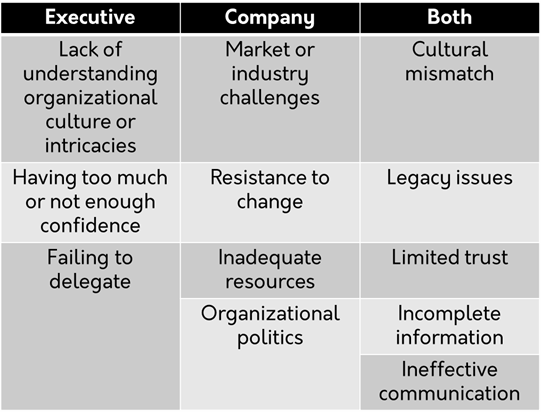3 Strategies for a Fast Start in Your New Leadership Role

Starting a new leadership role can be both exciting and challenging. According to recent estimates, anywhere from 38% to more than half of new leaders fail within their first 18 months. This occurs despite most of these leaders having a proven track record of success and demonstrating high intelligence, initiative and business savvy.
To get off to a robust and fast start in your new leadership role, read on and learn how to chart your path to success by:
- Identifying common roadblocks faced by mid to senior level executives.
- Analyzing tips from well-known executives who effectively transitioned into their new leadership role.
- Discovering strategies for successfully stepping into a new leadership role.
- Understanding how coaching supports and prepares executives for this transition.
Roadblocks for Mid to Senior Level Executives
Executives often face obstacles that hinder their success in new leadership positions and derail their intentions to excel. These roadblocks, illustrated in the following graphic, may be on the part of the executive themselves, the company or the interaction between them.

Navigating these challenges requires a combination of effective relationship building, communication, and adaptability, which we’ll further explore. Successful mid to senior level executives often integrate their experience with mentorship and continuous learning to overcome these roadblocks.
Recognized Executives Who Successfully Transitioned into Their New Leadership Role
Executives who successfully transitioned into a new role are notable for their ability to innovate and adapt. Let’s look at tips from three well-known executives on how to get off to a fast start in a new leadership role:
- Rose Marcario (former president and CEO of Patagonia) – When it comes to implementing change at a new company, Marcario advised leaders to first “understand and respect the culture that’s there,” then develop a following “by giving people something bigger than themselves to go toward.”
- Mary Barra (Chair and CEO of GM) – “Take personal responsibility. If you inherit a problem with your new job, don’t dismiss it as the last person’s legacy. Never hide behind your newbie status or use it as an excuse to put off what needs to be done. Own the problem, develop a plan to fix it and address it head on. Your team’s reputation depends not just on what you do right, but what you do if something goes wrong.”
- Marc Benioff (Chair and CEO of Salesforce) – Benioff led the creation of a management process at Salesforce called “V2MOM” (Vision, Values, Methods, Obstacles and Measures) to build alignment while growing quickly. This method is helpful throughout an organization’s life cycle, as it involves continuously assessing and defining priorities and goals. It answers five vital questions:
- Vision – What do you want to achieve?
- Values – What’s important to you?
- Methods – How do you get it?
- Obstacles – What is preventing you from being successful?
- Measures – How do you know you have it?
Strategies for Transitioning into a New Leadership Position
What causes leaders to fall short in new roles even when they have a strong track record of past success? While some struggle to overcome the obstacles shown above, others fail to assess or recognize the new challenges they’re about to face. They recall their past success in solving comparable problems and believe prior solutions will also work today.
They fail to recognize, however, that the ground has shifted beneath them – the environment, culture and even the history of where they are now can be radically different from where they were. To quote Marshall Goldsmith, “what got them here, won’t get them there.”
By focusing too much on the “what” and not enough on the “where, why, who and how,” they end up charting a path to setbacks, frustration, and ultimately, widening doubt about whether they were the right person for the seat.
Leaders transitioning into new roles must broaden their thinking and approach in three key areas – building strong relationships, communicating their vision, and staying agile.
Here are some strategies for doing so:
1. Build strong relationships in a new organizational culture
Begin by assessing the existing organizational culture to understand the history, values, norms and any unique dynamics that have shaped it. Then, develop the necessary insights to adapt to the new culture. Learn to decipher the unspoken rules, hierarchies and communication styles that govern behavior within the organization.
It’s also critical to identify key stakeholders along with influential individuals, internal networks and decision-makers. Prioritize relationship-building efforts based on the strategic importance of each stakeholder.
Likewise, bridge the gap between your leadership style and the existing culture. Identify areas where alignment is feasible and recognize where it might be necessary to gently challenge the status quo, while seeking to maintain harmony.
Finally, develop advanced conflict resolution skills to navigate any cultural clashes or tensions that arise. Be a mediator who seeks constructive solutions that honor both your vision and the existing culture.
2. Communicate your vision
Recognize the organization’s historical context and previous leadership’s initiatives. Position your vision as an evolution that builds upon past successes and addresses new challenges and opportunities.
In addition, master the art of executive storytelling by crafting narratives that resonate with the organization’s history and aspirations. Use anecdotes and metaphors that weave your vision into the fabric of the organization’s story.
Another way to communicate your vision is to back it with data and market insights. Senior executives often appreciate a rational and data-driven approach. Show how your vision aligns with strategic objectives and the potential for ROI. Also, engage with the senior team and key stakeholders and ensure alignment with your vision. Clearly articulate how your strategic direction benefits the organization’s shareholder value and long-term sustainability.
Above all, be an adaptive leader who can pivot and adjust your vision based on the challenges and opportunities unique to the new environment. This demonstrates your versatility to lead in diverse circumstances.
3. Stay agile in a new environment
Adapt your resource allocation strategies to the organization’s unique constraints and strengths by optimizing existing resources creatively. To anticipate or address the specific risks associated with the new organization’s culture, market dynamics, and history, develop a robust risk management strategy.
In this new environment, form agile teams or task forces that respond quickly to changing circumstances. Encourage experimentation and empower teams to make decisions within their areas of expertise. Furthermore, explore opportunities for strategic partnerships or collaborations within the industry or sector. This can provide access to additional resources and expand the organization’s agility.
Most importantly, foster a culture of continuous learning and adaptability within your team and the broader organization. Emphasize the importance of staying open to feedback, experimenting, and learning from both successes and failures.
Coaching Prepares Executives For a New Leadership Role
We’ve all heard the saying “it can be lonely at the top.” Coaching provides the transitioning executive with support they may not have within the company for sharing ideas, expressing concerns, or increasing their own self-awareness. Additionally, an executive and leadership coach can:
- Serve as a trusted advisor, ally, and non-judgmental champion.
- Uncover behaviors and beliefs that limit the executive’s effectiveness.
- Raise Emotional Intelligence (EQ) by identifying triggers that increase stress or diminish executive presence and develop strategies to intercept those disruptive impulses.
- Develop the executive’s active listening and speaking skills.
- Transform an executive from being a good leader to a great leader.
Whether an executive is ascending to a new role in their current company or moving to a new employer, getting off to a strong and fast start is vital for short and long-term success. While there’s much that can get in their way, focusing on three priority areas – cultivating strong relationships, communicating their vision and staying agile – avoids the pitfalls that trap many leaders and builds momentum for sustainable strong performance from day one.
If you want to learn how Leading Edge’s 4D Executive Coaching and Career Transition Coaching programs can support you in getting off to a fast start in your new role, schedule a complimentary discovery session today.